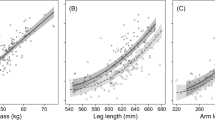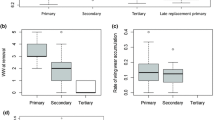Summary
In most vertebrates, males and females are believed to differ in terms of their investment in offspring. Dominance theory suggests that one way individuals of the sex with lower parental investment can increase reproductive success would be to dominate others of the same sex. The dominant competitors are thought to achieve preferred access to mates, and thus, have greater reproductive success than subordinates.
Reproduction in parthenogenetic Cnemidophorus uniparens normally proceeds without males, but individuals exhibit mounting behaviors in captivity that are typical of closely related Cnemidophorus species that reproduce sexually. Thus, these animals provide an unusual opportunity to study the effects of behavior on reproduction apart from copulation and fertilization. In this study relationships between dominance and reproduction were investigated in the unisexual lizard species, C. uniparens. Dominance hierarchies were rapidly established and maintained in the laboratory by agonistic encounters among individuals. The number of times an individual charged its cagemates was positively correlated with the number of clutches and eggs laid. Also, dominant animals who charged their cagemates were likely to win agonistic encounters; recipients of charges usually fled. Hierarchies based on different behaviors were not all related to reproduction. Charges as a predictor of dominance was unrelated to body length, percent increase in body length and time spent in the basking site. However, individuals with a high percent increase in body length spent more time basking. This is likely a result of the increased energy demands of growth in addition to reproduction. Physiological stress as measured by plasma corticosterone titers was unrelated to dominance. We suggest that dominance is an important factor affecting reproduction in C. uniparens.
Similar content being viewed by others
References
Andrews RM (1982) Patterns of growth in reptiles. In: Gans C, Pough FH (eds) Biology of the reptilia, vol 13. Academic Press, New York, pp 273–320
Bateman AJ (1948) Intra-sexual selection in Drosophila. Heredity 2:349–368
Bernstein IS (1981) Dominance: the baby and the bathwater. Behav Brain Sci 4:419–429
Boyd R, Silk J (1983) A method for assigning cardinal dominance ranks. Anim Behav 31:45–58
Brackin MF (1978) The relation of rank to physiological state in Cnemidophorus sexlineatus dominance hierarchies. Herpetologica 34:185–191
Brattstrom BF (1974) The evolution of reptilian social behavior. Am Zool 14:35–50
Carpenter CC (1967) Aggression and social structure in iguanid lizards. In: Milstead WW (ed) Lizard ecology, a Symposium. Univ Kans Press, pp 87–106
Cheney D, Seyfarth R, Smuts B (1986) Social relationships and social cognition in nonhuman primates. Science 234:1361–1366
Cole CJ (1975) Evolution of parthenogenic species of reptiles. In: Reinboth R (ed) Intersexuality in the animal kingdom. Springer, Berlin Heidelberg New York, pp 240–355
Cole CJ, Townsend CR (1983) Sexual behaviour in unisexual lizards. Anim Behav 31:724–728
Congdon JD, Vitt LJ, Hadley NF (1978) Parental investment: comparative reproductive energetics in bisexual and unisexual lizards, Genus Cnemidophorus. Am Nat 112:509–521
Crews D (1975) Psychobiology of reptilian reproduction. Science 189:1059–1065
Crews D (1982) On the origin of sexual behavior. Psychoneuroendocrinology 7:259–270
Crews D, Fitzgerald KT (1980) “Sexual” behavior in parthenogenetic lizards (Cnemidophorus). Proc Nat Acad Sci 77:499–502
Crews D, Silver R (1985) Reproductive physiology and behavior interactions in nonmammalian vertebrates. In: Adler N, Pfaff D, Goy RW (eds) Handbook of behavioral neurobiology, vol 7. Plenum Press, New York, pp 101–182
Crews D, Gustafson JE, Tokarz R (1983) Psychobiology of parthenogenesis in reptiles. In: Huey R, Schoener T, Pianka E (eds) Lizard ecology: Studies of a model organism. Harvard, Cambridge, pp 205–231
Crews D, Grassman M, Lindzey J (1986) Behavioral facilitation of reproduction in sexual and unisexual whiptail lizards. Proc Nat Acad Sci 83:9547–9550
Cuellar O (1971) Reproduction and the mechanism of meiotic restitution in the lizard Cnemidophorus uniparens. J Morphol 133:139–166
Cuellar O (1976) Intraclonal histocompatibility in a parthenogenic lizard: Evidence of genetic homogeneity. Science 193:150–153
Cuellar O (1977a) Genetic homogeneity and speciation in the parthenogenetic lizards, Cnemidophorus velox and Cnemidophorus neomexicanus: evidence from intraspecific histocompatibility. Evolution 31:24–31
Cuellar O (1977b) Animal parthenogenesis: a new evolutionary-ecological model is needed. Science 197:837–843
Dewsbury D (1981) Social dominance, copulatory behavior, and differential reproduction in deer mice (Peromyscus maniculatus). J Comp Psychol 57:135–159
Ferguson GW (1971) Observations on the behavior and interactions of two sympatric species of Sceloporus in Utah. Am Midl Nat 86:190–197
Grassman M, Crews D (1986) Progesterone induction of pseudocopulatory behavior and stimulus-response complementarity in an all-female lizard species. Horm Behav 20:327–335
Greenberg N, Chen T, Crews D (1984) Social status gonadal state, and adrenal stress response in the lizard, Anolis carolinensis. Horm Behav 18:1–11
Gustafson J, Crews D (1981) Effect of group size and physiological state of a cagemate on reproduction in the parthenogenetic lizard Cnemidophorus uniparens (Teiidae). Behav Ecol Sociobiol 8:267–272
Hand JL (1986) Resolution of social conflicts: dominance, egalitarianism, spheres of dominance, and game theory. Quart Rev Biol 61:201–220
Lehrman DS, Brody PN, Wortis RP (1961) The presence of the mate and of nesting material as stimuli for the development of incubation behavior and for gonadotropin secretion in the ring dove (Streptopelia risoria). Endocrinology 68:507–516
Leuck B (1985) Comparative social behavior of bisexual and unisexual whiptail lizards (Cnemidophorus). J Herpetol 19:492–506
Milstead WW (1970) Late summer behavior of the lizards Sceloporus merriami and Urosaurus ornatus in the field. Herpetologica 26:341–357
Moore MC, Whittier JM, Crews D (1984) Environmental control of seasonal reproduction in a parthenogenetic lizard, Cnemidophorus uniparens. Physiol Zool 57:544–549
Moore MC, Whittier JM, Crews D (1985a) Sex steroid hormones during the ovarian cycle of an all-female, parthenogenetic lizard and their correlation with pseudosexual behavior. Gen Comp Endocrinol 60:144–153
Moore MC, Whittier JM, Billy AJ, Crews D (1985b) Male-like behavior in an all-female lizard: relationship to ovarian cycle. Anim Behav 33:284–289
Stamps JA (1977) Social behavior and spacing patterns in lizards. In: Gans C, Tinkle DW (eds) Biology of the reptilia, vol 7. Academic Press, New York, pp 265–334
Trivers RL (1972) Parental investment and sexual selection. In: Campbell B (ed) Sexual selection and the descent of man. Aldine, Chicago, pp 136–179
Werner YL (1980) Apparent homosexual behavior in an all-female population of a lizard, Lepidodactylus lugubris and its probable interpretation. Z Tierpsychol 54:144–150
Whittier JM, Mason RT, Crews D (1987) Plasma steroid hormone levels of female red-sided garter snakes, Thamnophis sirtalis parietalis: Relationship to mating and gestation. Gen Comp Endocrinol 67:33–43
Author information
Authors and Affiliations
Rights and permissions
About this article
Cite this article
Grassman, M., Crews, D. Dominance and reproduction in a parthenogenetic lizard. Behav Ecol Sociobiol 21, 141–147 (1987). https://doi.org/10.1007/BF00303203
Received:
Accepted:
Issue Date:
DOI: https://doi.org/10.1007/BF00303203




